Page 27 of 576
27
For safety and security1
1-1. For safe useBefore driving ...................... 28
For safety drive ................... 30
Seat belts ............................ 32
SRS airbags ........................ 38
Front passenger occupant classification system ......... 50
Safety information for children ........................ 55
Child restraint systems........ 56
Installing child restraints...... 60
Exhaust gas precautions..... 77
1-2. Theft deterrent system Engine immobilizer system .............................. 78
Alarm................................... 80
Page 29 of 576
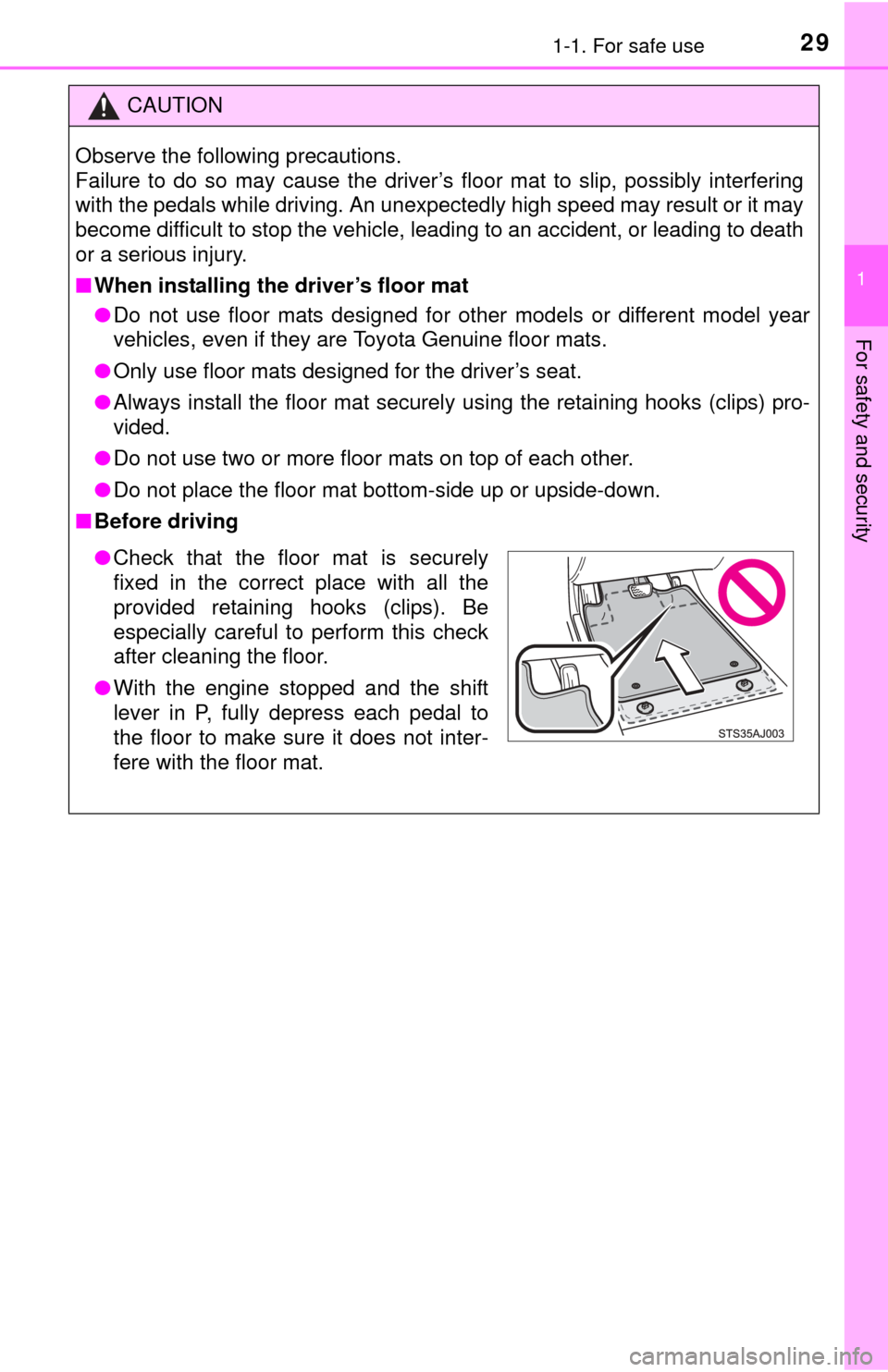
291-1. For safe use
1
For safety and security
CAUTION
Observe the following precautions.
Failure to do so may cause the driver’s floor mat to slip, possibly interfering
with the pedals while driving. An unexpectedly high speed may result or it may
become difficult to stop the vehicle, leading to an accident, or leading to death
or a serious injury.
■When installing the driver’s floor mat
● Do not use floor mats designed for other models or different model year
vehicles, even if they are Toyota Genuine floor mats.
● Only use floor mats designed for the driver’s seat.
● Always install the floor mat securely using the retaining hooks (clips) pro-
vided.
● Do not use two or more floor mats on top of each other.
● Do not place the floor mat bottom-side up or upside-down.
■ Before driving
● Check that the floor mat is securely
fixed in the correct place with all the
provided retaining hooks (clips). Be
especially careful to perform this check
after cleaning the floor.
● With the engine stopped and the shift
lever in P, fully depress each pedal to
the floor to make sure it does not inter-
fere with the floor mat.
Page 77 of 576
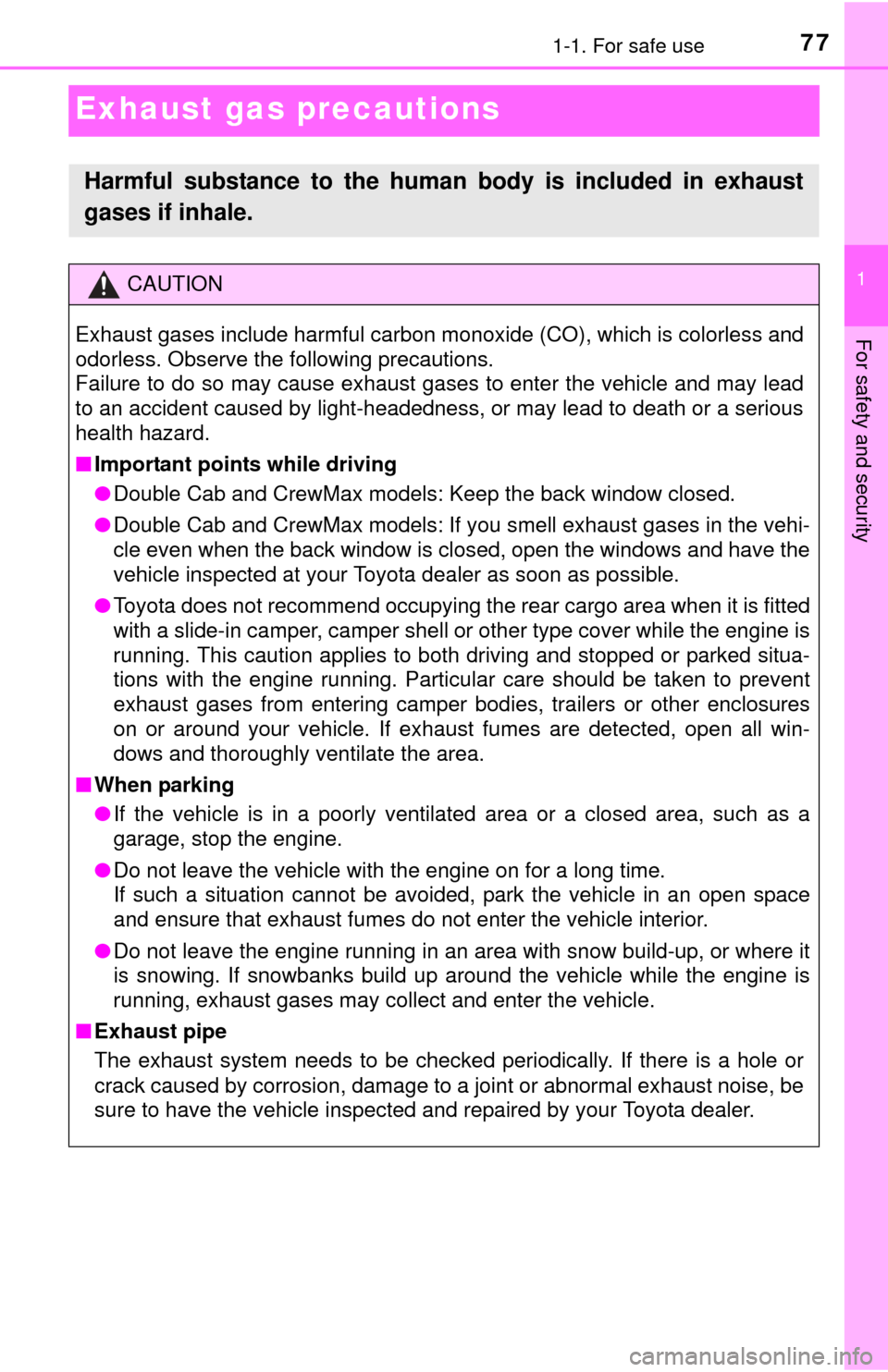
771-1. For safe use
1
For safety and security
Exhaust gas precautions
Harmful substance to the human body is included in exhaust
gases if inhale.
CAUTION
Exhaust gases include harmful carbon monoxide (CO), which is colorless and
odorless. Observe the following precautions.
Failure to do so may cause exhaust gases to enter the vehicle and may lead
to an accident caused by light-headedness, or may lead to death or a serious
health hazard.
■Important points while driving
● Double Cab and CrewMax models: Keep the back window closed.
● Double Cab and CrewMax models: If you smell exhaust gases in the vehi-
cle even when the back window is closed, open the windows and have the
vehicle inspected at your Toyota dealer as soon as possible.
● Toyota does not recommend occupying the rear cargo area when it is fitted
with a slide-in camper, camper shell or other type cover while the engine is
running. This caution applies to both driving and stopped or parked situa-
tions with the engine running. Particular care should be taken to prevent
exhaust gases from entering camper bodi es, trailers or other enclosures
on or around your vehicle. If exhaust fumes are detected, open all win-
dows and thoroughly ventilate the area.
■ When parking
● If the vehicle is in a poorly ventilated area or a closed area, such as a
garage, stop the engine.
● Do not leave the vehicle with the engine on for a long time.
If such a situation cannot be avoided, park the vehicle in an open space
and ensure that exhaust fumes do not enter the vehicle interior.
● Do not leave the engine running in an area with snow build-up, or where it
is snowing. If snowbanks build up around the vehicle while the engine is
running, exhaust gases may collect and enter the vehicle.
■ Exhaust pipe
The exhaust system needs to be checked periodically. If there is a hole or
crack caused by corrosion, damage to a joint or abnormal exhaust noise, be
sure to have the vehicle inspected and repaired by your Toyota dealer.
Page 78 of 576
781-2. Theft deterrent system
Engine immobilizer system
The indicator light flashes after
the key has been removed from
the engine switch to indicate that
the system is operating.
The indicator light stops flashing
after the registered key has been
inserted into the engine switch to
indicate that the system has been
canceled.
■System maintenance
The vehicle has a maintenance-free type engine immobilizer system.
■ Conditions that may cause the system to malfunction
●If the grip portion of the key is in contact with a metallic object
● If the key is in close proximity to or touching a key to the security system
(key with a built-in transponder chip) of another vehicle
: If equipped
The vehicle’s keys have built-in transponder chips that prevent
the engine from starting if a key has not been previously regis-
tered in the vehicle’s on-board computer.
Never leave the keys inside the vehicle when you leave the vehi-
cle.
Page 79 of 576
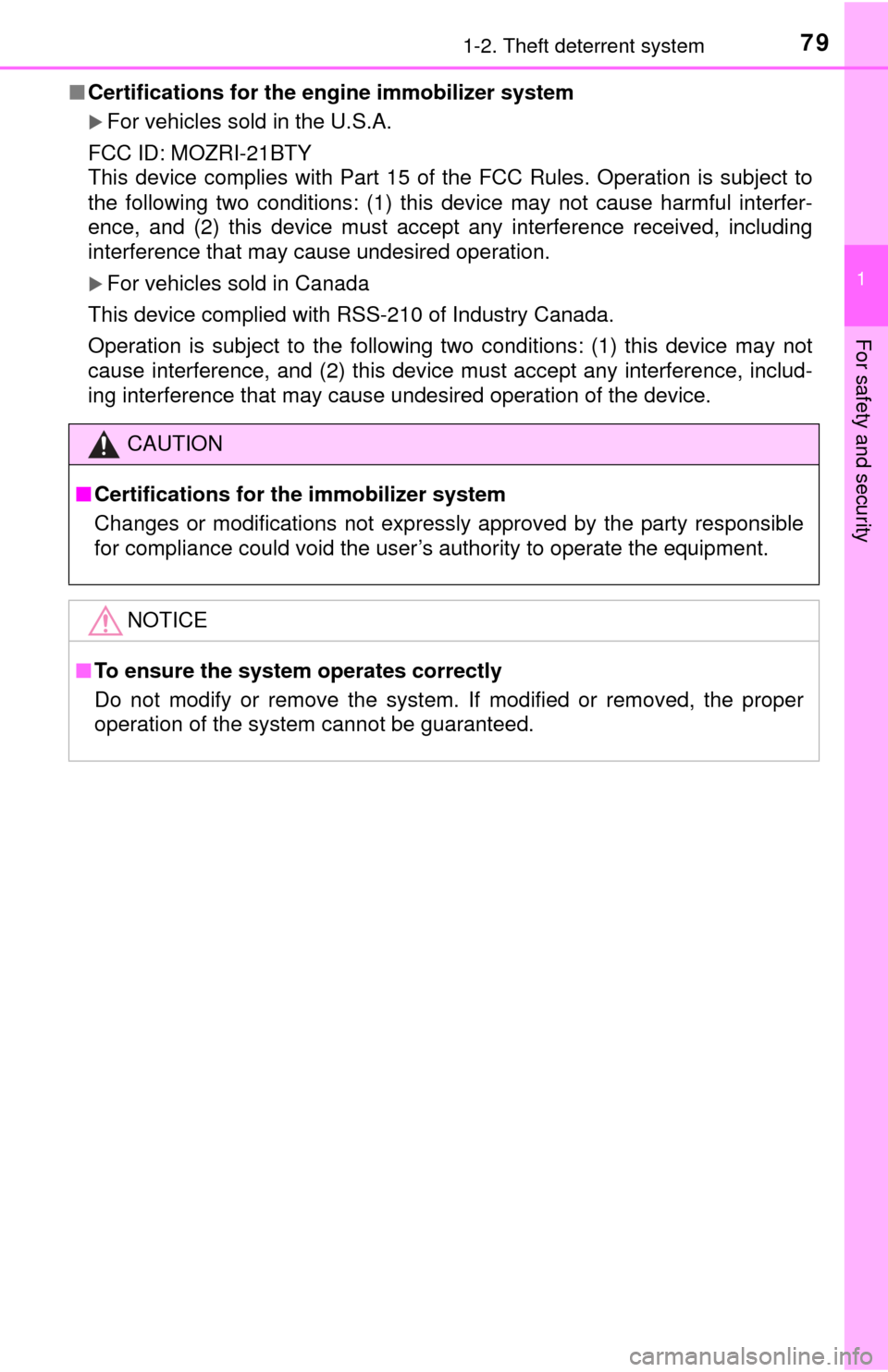
791-2. Theft deterrent system
1
For safety and security
■Certifications for the engine immobilizer system
For vehicles sold in the U.S.A.
FCC ID: MOZRI-21BTY
This device complies with Part 15 of the FCC Rules. Operation is subject to
the following two conditions: (1) this device may not cause harmful interfer-
ence, and (2) this device must accept any interference received, including
interference that may cause undesired operation.
For vehicles sold in Canada
This device complied with RSS-210 of Industry Canada.
Operation is subject to the following two conditions: (1) this device may not
cause interference, and (2) this device must accept any interference, includ-
ing interference that may cause undesired operation of the device.
CAUTION
■ Certifications for the immobilizer system
Changes or modifications not expressly approved by the party responsible
for compliance could void the user’s authority to operate the equipment.
NOTICE
■To ensure the system operates correctly
Do not modify or remove the system. If modified or removed, the proper
operation of the system cannot be guaranteed.
Page 80 of 576
801-2. Theft deterrent system
Alar m
The alarm uses light and sound to give an alert when an intrusion is
detected.
The alarm is triggered in the following situations when the alarm is
set:
●A locked door is unlocked or opene d in any way other than using a
key or wireless remote control. (The doors will lock again automati-
cally.)
● The hood is opened.
● Vehicles with the glass breakage sensor: The side windows are
tapped or broken.
Close the doors and hood, and
lock all the doors. The system will
be set automatically after 30 sec-
onds.
The indicator light changes from
being on to flashing when the sys-
tem is set.
Do one of the following to d eactivate or stop the alarms:
● Unlock the doors.
● Turn the engine switch to the “ACC” or “ON” position, or start the
engine. (The alarm will be deactivated or stopped after a few sec-
onds.)
: If equipped
The alarm
Setting the alarm system
Deactivating or stopping the alarm
Page 85 of 576
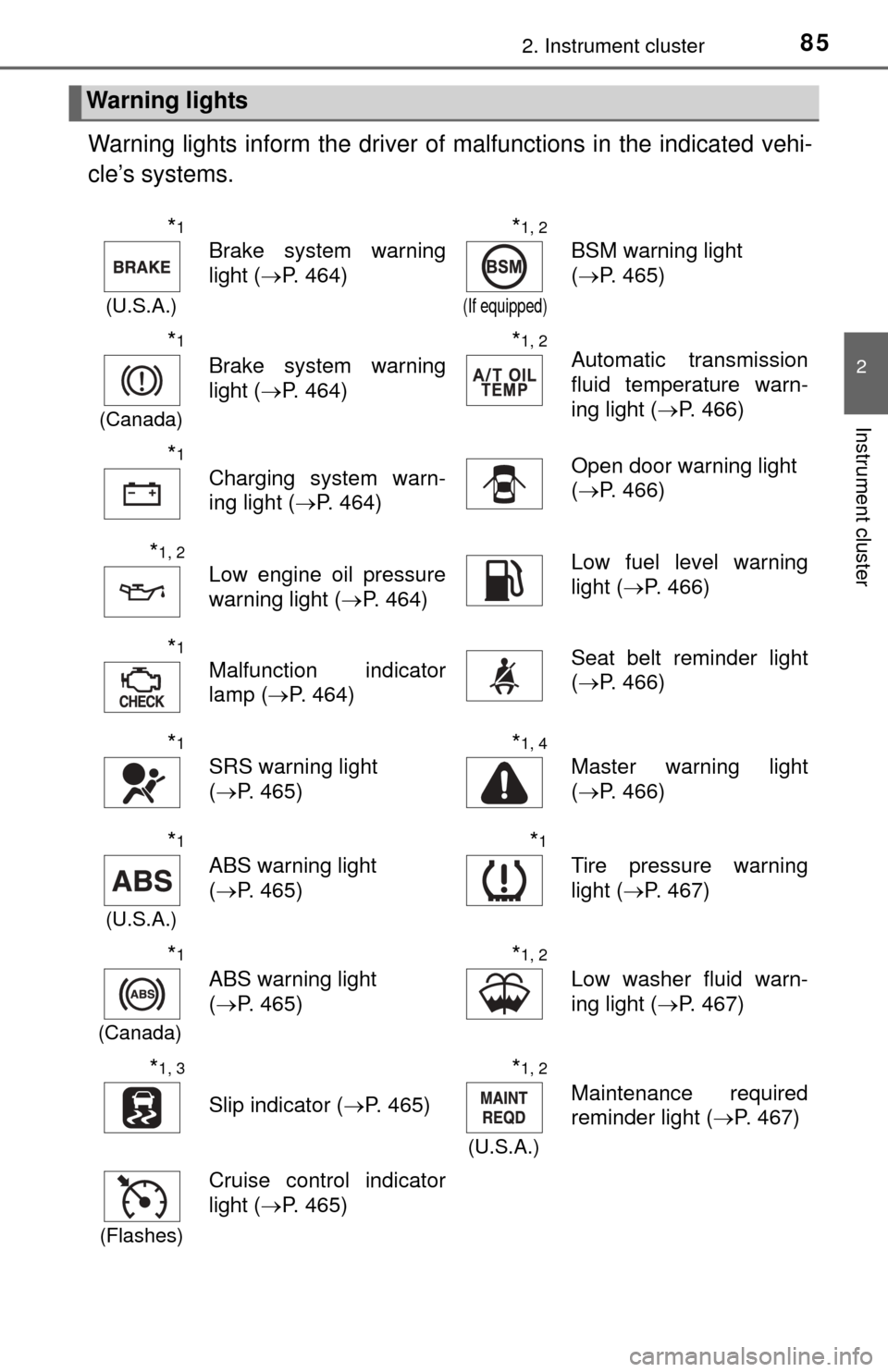
852. Instrument cluster
2
Instrument cluster
Warning lights inform the driver of malfunctions in the indicated vehi-
cle’s systems.
Warning lights
*1
(U.S.A.)
Brake system warning
light ( P. 464)
*1, 2
(If equipped)
BSM warning light
(P. 465)
*1
(Canada)
Brake system warning
light ( P. 464)
*1, 2Automatic transmission
fluid temperature warn-
ing light ( P. 466)
*1
Charging system warn-
ing light (P. 464)Open door warning light
(P. 466)
*1, 2
Low engine oil pressure
warning light ( P. 464)Low fuel level warning
light ( P. 466)
*1
Malfunction indicator
lamp ( P. 464)Seat belt reminder light
(P. 466)
*1
SRS warning light
(P. 465)
*1, 4
Master warning light
(P. 466)
*1
(U.S.A.)
ABS warning light
(P. 465)
*1
Tire pressure warning
light ( P. 467)
*1
(Canada)
ABS warning light
(P. 465)
*1, 2
Low washer fluid warn-
ing light ( P. 467)
*1, 3
Slip indicator ( P. 465)
*1, 2
(U.S.A.)
Maintenance required
reminder light ( P. 467)
(Flashes)
Cruise control indicator
light (P. 465)
Page 86 of 576
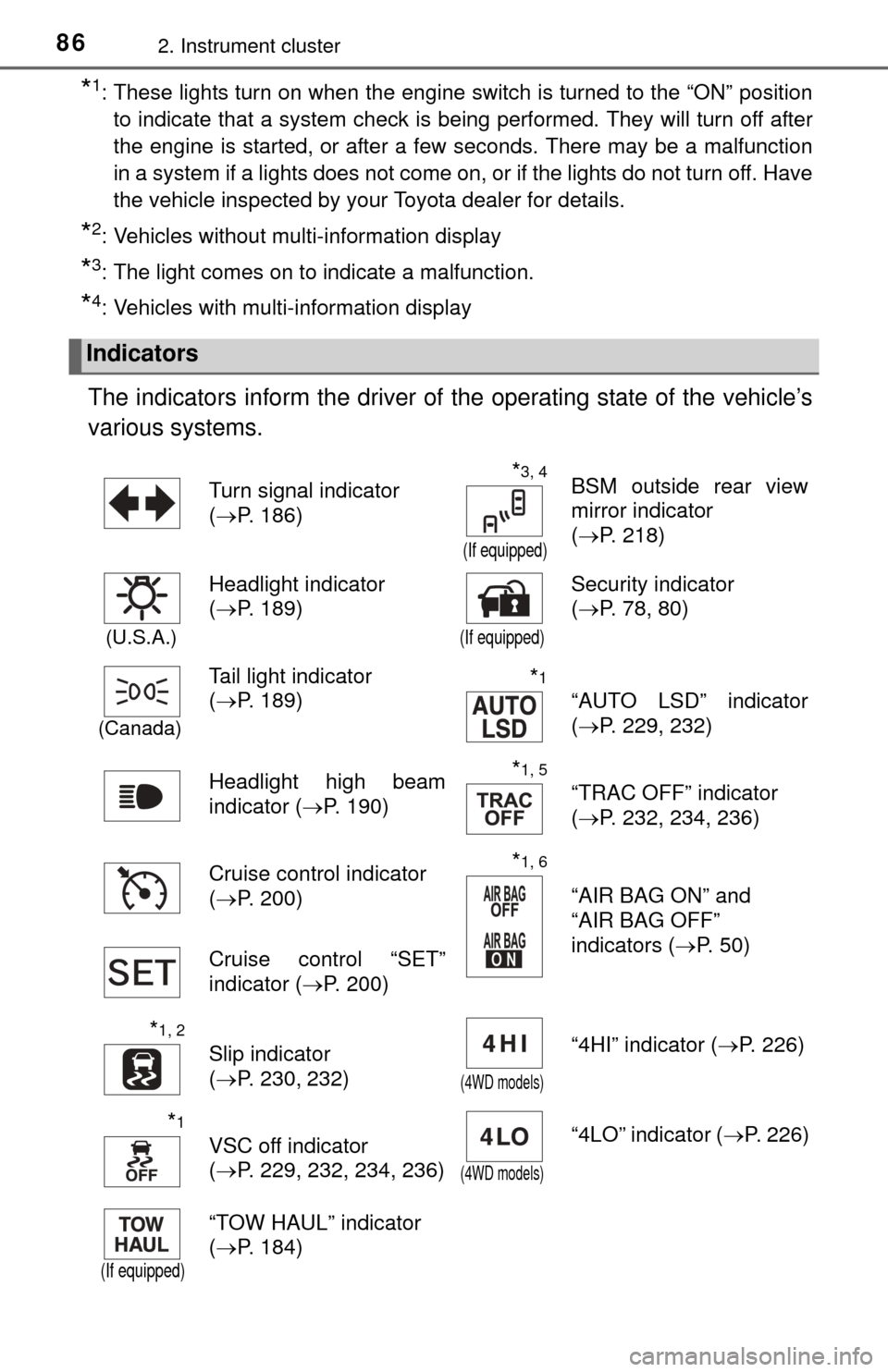
862. Instrument cluster
*1: These lights turn on when the engine switch is turned to the “ON” positionto indicate that a system check is being performed. They will turn off after
the engine is started, or after a few seconds. There may be a malfunction
in a system if a lights does not come on, or if the lights do not turn off. Have
the vehicle inspected by your Toyota dealer for details.
*2: Vehicles without multi-information display
*3: The light comes on to indicate a malfunction.
*4: Vehicles with multi-information display
The indicators inform the driver of the operating state of the vehicle’s
various systems.
Indicators
Turn signal indicator
( P. 186)*3, 4
(If equipped)
BSM outside rear view
mirror indicator
(P. 218)
(U.S.A.)
Headlight indicator
(P. 189)
(If equipped)
Security indicator
(P. 78, 80)
(Canada)
Tail light indicator
(P. 189)*1
“AUTO LSD” indicator
(P. 229, 232)
Headlight high beam
indicator ( P. 190)
*1, 5
“TRAC OFF” indicator
(P. 232, 234, 236)
Cruise control indicator
( P. 200)
*1, 6
“AIR BAG ON” and
“AIR BAG OFF”
indicators ( P. 50)
Cruise control “SET”
indicator ( P. 200)
*1, 2
Slip indicator
(P. 230, 232)
(4WD models)
“4HI” indicator ( P. 226)
*1
VSC off indicator
(P. 229, 232, 234, 236)
(4WD models)
“4LO” indicator ( P. 226)
(If equipped)
“TOW HAUL” indicator
(P. 184)